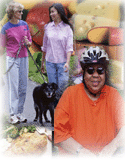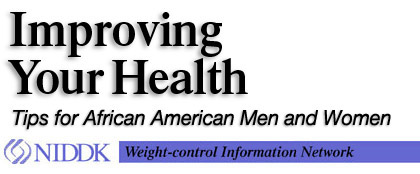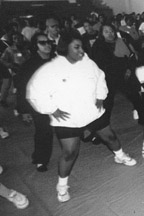
 |

|



(1,028KB)


|
|
 |
You do not have to stop eating chocolate cake
or start running marathons to improve your
health. Making small but steady changes in your
eating and physical activity habits—over
time—may help you lose weight if you need
to, feel better, and improve your health. The
information below can help you start to change
your physical activity and eating habits. When
you make changes to improve your health, you may
also move your friends and family to do the
same.
Back to top
|
|
|
|
What if I think I look
fine?
|
Even if you are overweight
according to charts and measures, you may like
the size and shape of your body and not want to
lose weight. Your friends and family may think
you look great too.
But the health benefits of
getting fit and eating well are clear. Once you
decide to lose weight, your loved ones may want
to join you on your journey to better health.
Back to
top
|
Am I risking my health by
being overweight?
|
Being overweight can be dangerous to your
health. If you are overweight or obese, you are
more likely to develop:
-
type 2 diabetes
-
high blood pressure
-
heart disease
-
certain forms of
cancer
You can help lower your risk for many health
problems by losing weight. Losing 5 to 10 percent
of your body weight can help improve your health.
For example, if you weigh 200 pounds, losing 10
to 20 pounds may help lower your blood pressure
and cholesterol level. Slow and steady weight
loss of 1/2 to 2 pounds per week is the safest
way to lose weight.
Back to top
|
How do I start to lose
weight and improve my health?
If you are a
man and over age 40 or a woman and over age 50,
or have chronic health problems such as heart
disease, high blood pressure, diabetes,
osteoporosis, or obesity, talk to your health
care provider before starting a vigorous physical
activity program.
|
To start towards a healthy weight and improve
your health, try to:
Be More Physically
Active
Regular moderate-intensity physical activity
can be fun and help you feel great. When you
share physical activity with your friends and
family, it can also be a social event. Make it
your goal to try to do at least 30 minutes of
moderate-intensity physical activity on most, or
better yet, all days of the week. You may need to
be physically active for more than 30 minutes a
day to help you lose and keep off extra
weight.
What is
moderate-intensity activity?
Sometimes starting and sticking with a
physical activity program can be a challenge.
Figuring out how to beat your physical activity
roadblocks may make it easier for you to get and
stay active.
Back to top
|
| |
Beat your physical
activity roadblocks!
|
|
|
| If you . .
. |
Then try . . . |
|
|
Sharing physical
activities such as walking, biking, or
playing tag with your child each day.
|
|
Do not have time or are too busy to
be physically active.
|
Doing 10 minutes of
moderate-intensity physical activity
three times a day, or putting more energy
than normal into activities like
housework, yard work, and playing with
the kids.
|
|
Do not like or do not
want to exercise.
|
Doing something you enjoy
like dancing to the radio, or planning
active outings with a friend, family
member, or group.
|
| Do not feel
safe being physically active in your
neighborhood. |
Forming a group of people to walk, jog,
or bike together, working out with
videos in your home, or walking in a
shopping mall.
|
|
|
|
|
|
Tips for Active
Women
You can be active and still
keep your hairstyle. Talk to your hairstylist
about a hair care routine and style that fit your
active life. You might try wearing:
- A natural
hairstyle.
- A style that can be
wrapped or pulled back.
- A short haircut.
- Braids, twists, or
locs.
|
Eat
Healthier
When you begin to change your eating habits to
improve your health, try to:
Make Healthier
Food Choices
A healthy eating plan includes a variety of
foods from every food group.
In January 2005, the U.S. Department of Health
and Human Services and the U.S. Department of
Agriculture jointly released the 2005 Dietary
Guidelines for Americans. These new
guidelines outline recommendations to promote
health and reduce the risk of chronic disease
through nutritious eating and physical
activity.
The new guidelines encourage Americans over 2
years of age to eat a variety of nutrient-dense
foods. Recommended items include fruits,
vegetables, fat-free or low-fat milk and milk
products, lean meats, poultry, fish, beans, eggs,
nuts, and whole grains such as brown rice and
whole-wheat bread. The guidelines also recommend
a diet low in saturated fats, trans
fats, cholesterol, salt (sodium), and added
sugars.
*For more information about recommended daily
intakes from various food groups, visit www.healthierus.gov/dietaryguidelines.
Back to top
|
Eat Just Enough for
You
To lose
weight, learn to eat fewer calories. Do this by
selecting foods that are lower in fat and
calories from each food group.
|
A healthy eating plan calls for making
healthy food choices and eating just enough for
you. Larger amounts of food have more
calories. Eating more calories than your body
needs may lead to weight gain.
Learning about the serving sizes of foods
can help you eat just enough for you. Try to
measure your food for a few days. This can help
you learn to recognize what one serving of a
food, such as 1/2 cup of rice, looks like on your
plate.
To lose weight, learn to eat fewer
calories. Do this by
selecting foods that are lower in fat and
calories from each food group. For example,
choose low-fat cheese and extra lean meat. Also,
choose plenty of vegetables. They are lower in
calories and fat than other foods and can help
you feel full.
Back to top
|
| |
Lower Fat Versions of
Favorite Foods
|
|
|
Instead of
This
|
Try This
|
|
Fried chicken
|
Baked, roasted, broiled,
grilled, or oven-fried chicken with the
skin removed.
|
|
Ham hocks, salt pork,
or fatback to flavor vegetables
|
Onions, garlic,
low-sodium chicken broth or bouillon,
smoked turkey, turkey bacon, or turkey
ham. (These meats are high in salt, so
use just a little bit.)
|
|
Regular ground
beef
|
Extra lean ground beef or lean
ground turkey breast.
|
|
French fries
|
Mashed potatoes made with
fat-free milk, a baked potato topped with
a vegetable or fruit salsa, or a
salad.
|
|
Sour cream
|
Low-fat or fat-free sour cream or
plain yogurt, or low-fat cream
cheese.
|
|
Salt
|
Spices, herbs, lemon, lime, or
vinegar. (Salt is not fattening, but it
may contribute to high blood pressure in
some people.)
|
| |
|
|
Do I need to drink
milk?

|
A healthy eating plan includes a
variety of foods that provides all of the
nutrients the body needs. Milk is a good source
of calcium. If you cannot digest lactose (the
sugar found in milk), there are many ways you can
get the calcium that milk offers, without
drinking regular milk.
-
Drink low-fat or fat-free
“lactose-reduced” milk, or
calcium-fortified soy-based beverages.
-
Choose low-fat yogurt or reduced-fat
hard cheeses like low-fat cheddar.
-
Eat dark leafy vegetables like collard
greens or kale.
- Eat canned fish with soft bones like
salmon.
|
|
Remember, sensible eating
and physical activity habits, followed over time,
are key to a healthy body, mind, and
spirit!
|
The path to improving your eating
and physical activity habits is not easy. But do
not give up. Remember, sensible eating and
physical activity habits, followed over time, are
key to a healthy body, mind, and spirit!
Back to
top
|
|
|
Weight-control Information Network
1 WIN Way
Bethesda, MD 20892-3665
Phone: (202) 828-1025
Toll-free number: 1-877-946-4627
FAX: (202) 828-1028
Email: WIN@info.niddk.nih.gov
The Weight-control Information
Network (WIN) is a national information service
of the National Institute of Diabetes and
Digestive and Kidney Diseases (NIDDK) of the
National Institutes of Health, which is the
Federal Government’s lead agency
responsible for biomedical research on nutrition
and obesity. Authorized by Congress (Public Law
103-43), WIN provides the general public, health
professionals, the media, and Congress with
up-to-date, science-based health information on
weight control, obesity, physical activity, and
related nutritional issues.
Publications produced by WIN are
reviewed by both NIDDK scientists and outside
experts. This publication was also reviewed by
Shiriki Kumanyika, Ph.D., M.P.H., Professor of
Epidemiology and Associate Dean for Health
Promotion and Disease Prevention, University of
Pennsylvania School of Medicine, and Gladys Gary
Vaughn, Ph.D., National Program Leader,
Cooperative Research, Education, and Extension
Service, U.S. Department of Agriculture.
This publication is not
copyrighted. WIN encourages users of this
brochure to duplicate and distribute as many
copies as desired.
Back to
top
|


|
U.S. DEPARTMENT OF HEALTH AND HUMAN
SERVICES
National Institutes of Health
NIH Publication No. 04-3494
August 2004
Revised July 2006
|
|
|







